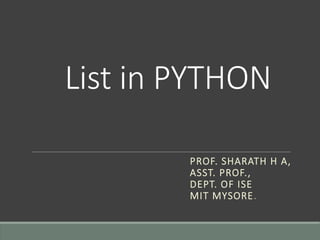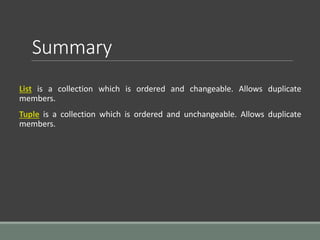Lists in Python allow storing and manipulating multiple items in a single variable. They can contain elements of different data types like strings, integers, and booleans. Lists can be accessed using indexes, sorted, copied, and joined. Common list methods include append(), insert(), remove(), pop(), sort(), and reverse() to add, remove, and rearrange list elements.





![list
Lists are used to store multiple items in a single variable. Lists in Python can
be created by just placing the sequence of items inside the square brackets[].
Syntax
Listname = [item1, item2, ……,item n]
Example
mylist = ["apple", "banana", "cherry"]](https://image.slidesharecdn.com/list-220211112534/85/List-in-Python-6-320.jpg)


![List Items - Data Types
String, int and boolean data types:
Example
list1 = ["apple", "banana", "cherry"]
list2 = [1, 5, 7, 9, 3]
list3 = [True, False, False]
list4 = ["abc", 34, True, 40, "male"]GUESS???](https://image.slidesharecdn.com/list-220211112534/85/List-in-Python-9-320.jpg)
![type()-What is the data type of a list?
From Python's perspective, lists are defined as objects with the data
type 'list':
Example
mylist = ["apple", "banana", "cherry"]
print(type(mylist))
OUTPUT: <class 'list'>](https://image.slidesharecdn.com/list-220211112534/85/List-in-Python-10-320.jpg)
![Allow Duplicates- Lists allow duplicate values
Since lists are indexed, lists can have items with the same value:
Example
Thislist=["apple", "banana", "cherry", "apple", "cherry"]
print(thislist)
OUTPUT: apple, banana, cherry, apple, cherry](https://image.slidesharecdn.com/list-220211112534/85/List-in-Python-11-320.jpg)
![List Length-Print the number of items in the list
To determine how many items a list has, use the len() function:
Example
thislist = ["apple", "banana", "cherry"]
print(len(thislist))
OUTPUT: 3](https://image.slidesharecdn.com/list-220211112534/85/List-in-Python-12-320.jpg)
![Python List count() Method
The count() method returns the number of elements with the specified value.
Syntax
list.count(value)
Example
Return the number of times the value 9 appears int the list:
points = [1, 4, 2, 9, 7, 8, 9, 3, 1]
x = points.count(9)
OUTPUT: 2](https://image.slidesharecdn.com/list-220211112534/85/List-in-Python-13-320.jpg)
![Python List index() Method
The index() method returns the position at the first occurrence of the specified
value.
Syntax
list.index(elmnt)
Example
What is the position of the value 32:
fruits = [4, 55, 64, 32, 16, 32]
x = fruits.index(32)
OUTPUT: 3](https://image.slidesharecdn.com/list-220211112534/85/List-in-Python-14-320.jpg)
![Access Items-Print the specific item of the list:
List items are indexed and you can access them by referring to the
index number:
Example
thislist = ["apple", "banana", "cherry"]
print(thislist[1])
OUTPUT: banana](https://image.slidesharecdn.com/list-220211112534/85/List-in-Python-15-320.jpg)
![Access Items-Negative Indexing
Negative indexing means start from the end
-1 refers to the last item, -2 refers to the second last item etc.
Example
Print the last item of the list:
thislist = ["apple", "banana", "cherry"]
print(thislist[-1])
OUTPUT: cherry](https://image.slidesharecdn.com/list-220211112534/85/List-in-Python-16-320.jpg)
![Access Items-Range of Indexes
You can specify a range of indexes by specifying where to start and where to end the
range.
When specifying a range, the return value will be a new list with the specified items.
Example
Return the third, fourth, and fifth item:
thislist = ["apple", "banana", "cherry", "orange", "kiwi", "melon", "mango"]
print(thislist[2:5])
OUTPUT:['cherry', 'orange', 'kiwi']](https://image.slidesharecdn.com/list-220211112534/85/List-in-Python-17-320.jpg)

![Access Items-Check if Item Exists
To determine if a specified item is present in a list use the in keyword:
Example
Check if "apple" is present in the list:
thislist = ["apple", "banana", "cherry"]
if "apple" in thislist:
print("Yes, 'apple' is in the fruits list")
OUTPUT: Yes, 'apple' is in the fruits list](https://image.slidesharecdn.com/list-220211112534/85/List-in-Python-19-320.jpg)
![Change List Items
To change the value of a specific item, refer to the index number:
Example
Change the second item:
thislist = ["apple", "banana", "cherry"]
thislist[1] = "blackcurrant"
print(thislist)
OUTPUT:[apple, blackcurrant, cherry]](https://image.slidesharecdn.com/list-220211112534/85/List-in-Python-20-320.jpg)
![Change List Items- Change a Range of Item Values
To change the value of items within a specific range, define a list with the new
values, and refer to the range of index numbers where you want to insert the new
values:
Example
Change the values "banana" and "cherry" with the values "blackcurrant" and
"watermelon":
thislist = ["apple", "banana", "cherry", "orange", "kiwi", "mango"]
thislist[1:3] = ["blackcurrant", "watermelon"]
print(thislist)
OUTPUT:](https://image.slidesharecdn.com/list-220211112534/85/List-in-Python-21-320.jpg)
![Guess??
Example
thislist = ["apple", "banana", "cherry"]
thislist[1:3] = ["watermelon"]
print(thislist)
OUTPUT:](https://image.slidesharecdn.com/list-220211112534/85/List-in-Python-22-320.jpg)
![Change List Items- Insert()
To insert a new list item, without replacing any of the existing values, we can
use the insert() method.
The insert() method inserts an item at the specified index:
Syntax
insert(position, item)
Example
thislist=["apple", "banana", "cherry"]
thislist.insert(2,"watermelon")
print(thislist)](https://image.slidesharecdn.com/list-220211112534/85/List-in-Python-23-320.jpg)
![Add List Items- Append Items
To add an item to the end of the list, use the append() method:
Syntax
list.append(elmnt)
Example
Using the append() method to append an item:
thislist = ["apple", "banana", "cherry"]
thislist.append("orange")
print(thislist)
OUTPUT:['apple', 'banana', 'cherry', 'orange']](https://image.slidesharecdn.com/list-220211112534/85/List-in-Python-24-320.jpg)
![Add List Items- Insert Items
To insert a list item at a specified index, use the insert() method.
Example
Insert an item as the second position:
thislist = ["apple", "banana", "cherry"]
thislist.insert(1, "orange")
print(thislist)
OUTPUT:
GUESS??](https://image.slidesharecdn.com/list-220211112534/85/List-in-Python-25-320.jpg)
![Add List Items- Extend List
To append elements from another list to the current list, use
the extend() method.
Syntax
list.extend(iterable)
Example
Add the elements of tropical to thislist:
thislist = ["apple", "banana", "cherry"]
tropical = ["mango", "pineapple", "papaya"]
thislist.extend(tropical)
print(thislist)
OUTPUT:](https://image.slidesharecdn.com/list-220211112534/85/List-in-Python-26-320.jpg)
![Remove List Items-Remove
Specified Item
The remove() method removes the specified item.
Example
Remove "banana":
thislist = ["apple", "banana", "cherry"]
thislist.remove("banana")
print(thislist)
OUTPUT: [“apple”, “cherry”]](https://image.slidesharecdn.com/list-220211112534/85/List-in-Python-27-320.jpg)
![Remove List Items- Remove Specified
Index
The pop() method removes the specified index.
Example
Remove the second item:
thislist = ["apple", "banana", "cherry"]
thislist.pop(1)
print(thislist)
OUTPUT:](https://image.slidesharecdn.com/list-220211112534/85/List-in-Python-28-320.jpg)
![Remove List Items- Remove Specified
Index(del)
The del keyword also removes the specified index:
Example
Remove the first item:
thislist = ["apple", "banana", "cherry"]
del thislist[0]
print(thislist)
OUTPUT:](https://image.slidesharecdn.com/list-220211112534/85/List-in-Python-29-320.jpg)
![Guess???
thislist = ["apple", "banana", "cherry"]
thislist.pop()
print(thislist)
thislist = ["apple", "banana", "cherry"]
del thislist
OUTPUT:
OUTPUT:](https://image.slidesharecdn.com/list-220211112534/85/List-in-Python-30-320.jpg)
![Remove List Items-Clear the List
The clear() method empties the list. The list still remains, but it has no
content.
Syntax
list.clear()
Example
Clear the list content:
thislist = ["apple", "banana", "cherry"]
thislist.clear()
print(thislist)
OUTPUT:[ ]](https://image.slidesharecdn.com/list-220211112534/85/List-in-Python-31-320.jpg)
![Loop Through a List
Example
Print all items in the list, one by one:
thislist = ["apple", "banana", "cherry"]
for x in thislist:
print(x)
OUTPUT:
apple
banana
cherry
For-loop
While-loop
Do-while loop](https://image.slidesharecdn.com/list-220211112534/85/List-in-Python-32-320.jpg)
![Python - Sort Alphanumerically
List objects have a sort() method that will sort the list alphanumerically,
ascending, by default:
Example
Sort the list alphabetically:
thislist = ["orange", "mango", "kiwi", "pineapple", "banana"]
thislist.sort()
print(thislist)
OUTPUT:['banana', 'kiwi', 'mango', 'orange', 'pineapple']](https://image.slidesharecdn.com/list-220211112534/85/List-in-Python-33-320.jpg)
![Python - Sort numerical
Example
Sort the list numerically:
thislist = [100, 50, 65, 82, 23]
thislist.sort()
print(thislist)
thislist = [10, "mango", "kiwi",95, "pineapple", "banana",40,67]
thislist.sort()
print(thislist)
OUTPUT:[23, 50, 65, 82, 100]
OUTPUT:
GUESS](https://image.slidesharecdn.com/list-220211112534/85/List-in-Python-34-320.jpg)
![Python - Sort Descending
To sort descending, use the keyword argument reverse = True:
Example
Sort the list descending:
thislist = ["orange", "mango", "kiwi", "pineapple", "banana"]
thislist.sort(reverse = True)
print(thislist)
OUTPUT: ['pineapple', 'orange', 'mango', 'kiwi', 'banana']](https://image.slidesharecdn.com/list-220211112534/85/List-in-Python-35-320.jpg)
![Python - Case Insensitive Sort
By default the sort() method is case sensitive, resulting in all capital letters being
sorted before lower case letters:
Example
Case sensitive sorting can give an unexpected result:
thislist = ["banana", "Orange", "Kiwi", "cherry"]
thislist.sort()
print(thislist)
thislist.sort(key = str.lower)
OUTPUT: ['Kiwi', 'Orange', 'banana', 'cherry']](https://image.slidesharecdn.com/list-220211112534/85/List-in-Python-36-320.jpg)
![Python - Reverse Order
The reverse() method reverses the current sorting order of the elements.
Example
Reverse the order of the list items:
thislist = ["banana", "Orange", "Kiwi", "cherry"]
thislist.reverse()
print(thislist)
OUTPUT: ['cherry', 'Kiwi', 'Orange', 'banana']](https://image.slidesharecdn.com/list-220211112534/85/List-in-Python-37-320.jpg)
![Python - Copy Lists
You cannot copy a list simply by typing list2 = list1, because: list2 will only be
a reference to list1, and changes made in list1 will automatically also be made
in list2.
There are ways to make a copy, one way is to use the built-in List method copy().
Example
Make a copy of a list with the copy() method:
thislist = ["apple", "banana", "cherry"]
mylist = thislist.copy()
print(mylist)
OUTPUT: ['apple', 'banana', 'cherry']](https://image.slidesharecdn.com/list-220211112534/85/List-in-Python-38-320.jpg)
![Python - Join Lists- Join Two Lists
There are several ways to join, or concatenate, two or more lists in Python.
One of the easiest ways are by using the + operator.
Example
Join two list:
list1 = ["a", "b", "c"]
list2 = [1, 2, 3]
list3 = list1 + list2
print(list3)
OUTPUT: ['a', 'b', 'c', 1, 2, 3]](https://image.slidesharecdn.com/list-220211112534/85/List-in-Python-39-320.jpg)
![Cont…
you can use the extend() method, which purpose is to add elements from one
list to another list:
Example
Use the extend() method to add list2 at the end of list1:
list1 = ["a", "b" , "c"]
list2 = [1, 2, 3]
list1.extend(list2)
print(list1)
OUTPUT: ['a', 'b', 'c', 1, 2, 3]](https://image.slidesharecdn.com/list-220211112534/85/List-in-Python-40-320.jpg)
![Cont…
Example
Add a list to a list:
a = ["apple", "banana", "cherry"]
b = ["Ford", "BMW", "Volvo"]
a.append(b)
OUTPUT: ['apple', 'banana', 'cherry', ["Ford", "BMW", "Volvo"]]](https://image.slidesharecdn.com/list-220211112534/85/List-in-Python-41-320.jpg)

